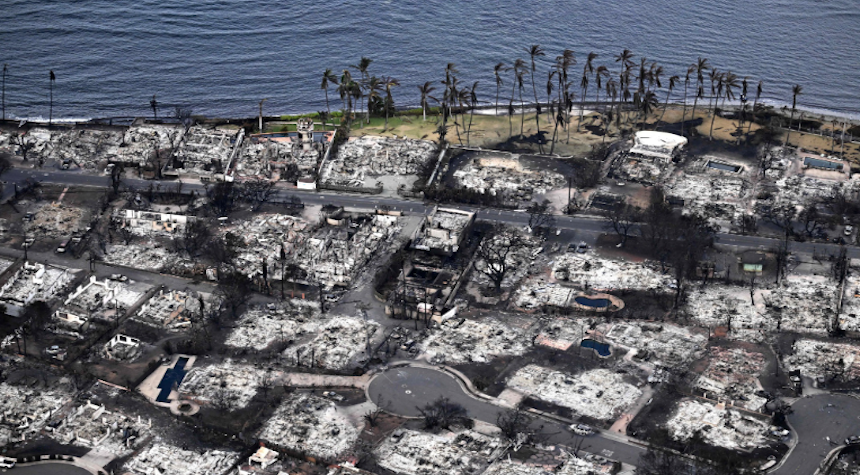Last August, President Biden was a photo-op for the cameras when he was lei’d on Maui in the aftermath of America’s most deadly wildfire. Six months after the fire, Biden has been accused of neglecting victims. Someone is slow-walking recovery and conspiracy theories are all over.
Lahaina was hardest hit, with more than 100 deaths, 70 injuries, three missing, and more than 2,000 homes and buildings destroyed. High winds accelerated the spread of fires, and – here’s where it got strange – civil defense sirens never went off, despite Hawaii being home to the largest outdoor integrated siren warning system in existence. Maui has more than 80 of these sirens.
Six months after the Lahaina Fire, the victims still have more questions than they do answers and are more resentful of government assistance.
Update On The Lahaina, Maui Fire Devastation Zone In Hawaii pic.twitter.com/UDyuKippA7
— Truth Slinger X (@TruthSlingerX) February 1, 2024
Nick Sortor, who is a frequent critic of the government and a guest on Tucker Carlson, said Tuesday that Lahaina’s cleanup had “literally only just begun about two weeks ago.” He wants to know why. He also posted:
At least 2100 homes have been charred by the fire
The average number of lots sold per weekday is only two
Seven trucks only are used for cleanup
If that is the case, it’s a damning assessment of progress made in six months. Sortor said, “Even worse, even when your lot has been cleared, you are STILL not allowed start rebuilding.”
Legal complications could be a factor for the delays. According to an AP report last year, residents of Lahaina who were displaced by the fires “might be unable to afford to stay there once it’s rebuilt” if zoning laws are not changed.
The price of this new housing is likely to be much higher than the prices in Lahaina that were already high before the fire. The University of Hawaii Economic Research Organization has warned that the destroyed housing stock provided renters with reasonable options. The problem is now known as “disaster-gentrification.”
Keli’i akina of Grassroot Institute of Hawaii warned in October that “families, individuals and businesses who own homes and businesses in Lahaina shouldn’t have their property rights arbitrarily taken away to satisfy the grandiose plans of some bureaucracy.” In order to achieve this, the county should provide an expedited permit process for homes and businesses that have been damaged or destroyed in the fire. However, my research has revealed no local efforts in Lahaina aimed at rezoning or streamlining processes to benefit those who lost their property in the fires.
It’s no wonder that people latch on to conspiracy theories.
Hawaii could have kept the civil defense sirens quiet to burn out locals, and replace them by new wealthy residents.
Let me make my position clear about Maui right now. Lahaina is being treated like a crime scene and I believe there are thousands of victims. It is a crime scene. Who, how, why, what??? They are not allowing even the residents to enter the area and even blocking aid. It is a…
— Derek Broes (@WillingWitness) August 13, 2023
According to another theory, blue tarps were used to save the homes of billionaires and not everyone else.
Remember when the BILLIONAIRES in Maui all had their roofs covered in BLUE TARPS, then after the fire, NOTHING BLUE WAS BURNED and they called us all C0NSPIRACY THEORISTS?
What do you think now? https://t.co/DSwdAVh7pU pic.twitter.com/Y0gzjLfFK7
— 𝕏 ƤΔʊ𝐋 ЯΞVΞЯΞ 𝕏𓂀 (@Paul_RevereJr) February 5, 2024
The issue is not how the blue tarps were supposed to have stopped fires that were so hot they melted Lahaina’s fire hydrants. It’s not the tarps that are at fault, but how inept, slow, and uncooperative government is.
What they did to Maui, they now have also done to Chile. Same MO. Neither place was a natural fire. They are deliberately wiping out whole regions, whole populations of people, through directed energy weapons. #Maui #Chile #wildfires #dew #directenergyweapons pic.twitter.com/UqOSmD8ix4
— Gretchen Strater⚓️⛵️🇺🇸🇮🇱 (@GretchenStrater) February 5, 2024
Directed energy weapons are not the only way to ignite fires.


